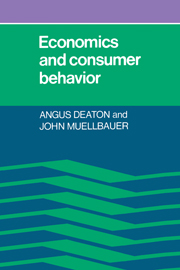Book contents
- Frontmatter
- Contents
- List of tables and figures
- Preface
- PART ONE CONSUMER DEMAND ANALYSIS
- PART TWO SEPARABILITY AND AGGREGATION
- PART THREE WELFARE AND CONSUMER BEHAVIOR
- PART FOUR EXTENSIONS AND APPLICATIONS
- 10 The quality of goods and household production theory
- 11 Labor supply
- 12 The consumption function and intertemporal choice
- 13 The demand for durable goods
- 14 Choice under uncertainty
- References
- List of notation
- Name index
- Subject index
12 - The consumption function and intertemporal choice
Published online by Cambridge University Press: 05 June 2012
- Frontmatter
- Contents
- List of tables and figures
- Preface
- PART ONE CONSUMER DEMAND ANALYSIS
- PART TWO SEPARABILITY AND AGGREGATION
- PART THREE WELFARE AND CONSUMER BEHAVIOR
- PART FOUR EXTENSIONS AND APPLICATIONS
- 10 The quality of goods and household production theory
- 11 Labor supply
- 12 The consumption function and intertemporal choice
- 13 The demand for durable goods
- 14 Choice under uncertainty
- References
- List of notation
- Name index
- Subject index
Summary
We have already discussed, in Chapter 4, the straightforward extension of the neoclassical utility maximizing model to problems involving choice over consumption in different time periods. In this chapter, we extend the analysis in several directions. Section 12.1 considers various aspects of intertemporal planning, especially in the context of the individual's life cycle. First, the model is extended to allow simultaneous choice of consumption and labor supply, and we discuss how, given freedom of choice, we might expect consumers to vary their work and consumption levels in response to variations over the life cycle in prices and wages. We then turn to the more conventional case of constrained labor supply as discussed in Chapter 4, and illustrate the derivation of the consumption function with a model based on the AIDS of Chapter 3. The relationship between the consumption function and systems of demand equations is also briefly considered. Liquidity constraints in the form of borrowing restrictions or different rates of interest on borrowing and lending are then discussed, and their influence in raising the marginal propensity to consume is emphasized. Finally, we discuss the implications of the analysis for the relationship between the aggregates of consumption, income, and wealth. Section 12.2 considers the dynamics of the link between income and consumption, not only within the full intertemporal model but also taking into account other explanations and the econometric evidence. Section 12.3 is concerned with questions of imperfect information.
- Type
- Chapter
- Information
- Economics and Consumer Behavior , pp. 309 - 344Publisher: Cambridge University PressPrint publication year: 1980



